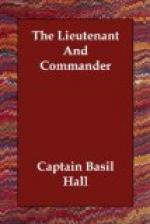Be this as it may, the yards come sliding down the well-greased masts; the men lie out to the right and left, grasp the tumultuous canvas, drag out the earings, and tie the points, with as perfect deliberation as if it were a calm, only taking double pains to see that all is right and tight, and the reef-band straight along the yard. The order has been given to take in the second and third reefs only; but the men linger at their posts, expecting the further work which they know is necessary. The captain of the top, instead of moving in, continues to sit astride the spar, dangling his legs under the weather yard-arm with the end of the close reef-earing in his hand, quite as much at his ease as any well-washed sea-bird that ever screamed defiance to a pitiless south-wester.
Johnny’s anticipations prove right, for the anxious commander, after gazing twice or thrice to windward, again consulting his barometer, looking six or eight times at his watch in as many minutes, to learn how many hours of daylight are yet above the horizon, and perhaps also stealing a professional opinion from his first lieutenant, an officer probably of much more technical experience than himself, decides upon close-reefing. If he be a man of sense, and wishes the work to be done quickly and well, he must not now hesitate about starting the topsail sheets, and it will certainly be all the better if one or both the clew-lines be likewise hauled close up.
The mainsail is now to be taken in; and as the method of performing this evolution has long been a subject of hot controversy at sea, I take the opportunity of saying, that Falconer’s couplet,—
“For he who strives
the tempest to disarm
Will never first embrail the
lee yard-arm,”
has, in my opinion, done a world of mischief, and split many thousands of sails.
I, at least, plead guilty to having been sadly misled by this authority for many years, since it was only in the last ship I commanded that I learned the true way to take in the mainsail when it blows hard. The best practice certainly is, to man both buntlines and the lee leechline well, and then to haul the LEE clew-garnet close up, before starting the tack or slacking the bowline. By attending to these directions, the spar is not only instantaneously relieved, but the leeward half of the sail walks sweetly and quietly up to the yard, without giving a single flap. After which the weather-clew comes up almost of itself, and without risk or trouble.




